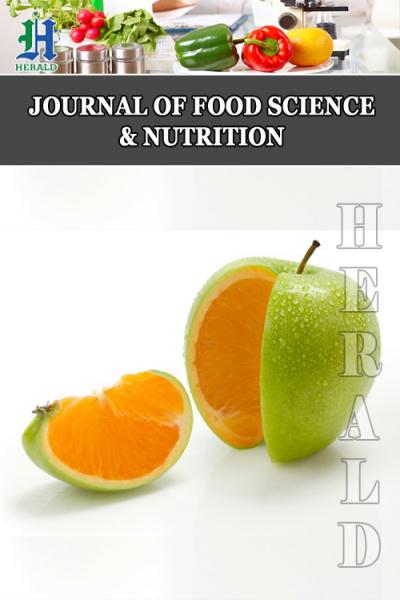
Drivers-of-Liking (DOL) for Boiled Milk among Women of Reproductive Age and Children Aged between One and Five Years in Peri-Urban Communities in Ghana
*Corresponding Author(s):
Maame Yaakwaah Blay AdjeiDepartment Of Nutrition And Food Science, University Of Ghana, Legon, Ghana
Tel:+233 545525974,
Email:myblay@ug.edu.gh
Abstract
Raw milk is heat treated in different ways to improve the safety of the milk for consumption. The heat treatment imparts different sensory properties to the milk that may influence its acceptance by consumers. In Ghana, fresh milk is boiled and sold locally to consumers. Generally, consumption amongst women of reproductive age and children under five is low. In this study, the sensory properties that drive liking for local boiled milk and other heat-treated milks in women of reproductive age and children between 1 and 5 years of age was studied. External preference mapping was used to understand the sensory properties of the milks that were liked by the two consumer groups. The sensory properties of boiled milk that made women of reproductive age like a particular product was its sweet and salty taste, smooth mouthfeel and artificial flavour. For children between 1 and 5 years, the oily aftertaste, boiled egg aroma as well as its sweet taste made them like the same product as the adults. This product also had a cooked aroma and flavour which could have influenced liking in the consumer groups. A small minority of adult consumers liked products that had a smooth and runny appearance with a raw/uncooked note.
Keywords
INTRODUCTION
Ghana is a developing country facing malnutritional challenges amongst children and women of reproductive age [1-3]. The first thousand days of life can positively or negatively impact the long term health of an individual [4-6]. This means that the nutritional status of an adult woman is directly associated with nutritional intake at birth. It is therefore necessary to provide the needed nutrients for optimal growth of children at an early age so as to produce healthy adults.
Milk is an important food commodity when it comes to the provision of nutrients for growth and development. It contains high amounts of calcium for maximal bone mineralization; omega-3 fats which help prevent the onset of cardiovascular diseases; vitamins B, E, selenium and zinc which help in the regulation of blood sugar and the removal of free radicals from the body and also contain complete proteins to promote normal growth and development [7].
Despite the many health benefits of milk, milk consumption in developing countries like Ghana is relatively low compared with other developed countries. Although consumption of dairy products is on the rise in many urban communities in Ghana, generally, fresh milk consumption is very low. There are some communities in Ghana where dairy activities may influence milk consumption patterns of consumers who live in these areas. Dairy communities in this context are defined as communities where dairying activities such as farming, processing and marketing occur. In Ghana, there are pockets of such areas typically in peri-urban communities.The demand for milk in these communities and most developing countries as a whole is expected to increase due to drivers like increasing income levels, urbanization, social and cultural factors.
Raw milk is often subjected to heat treatment to make it safe for consumption. The heat treatment imparts different sensory properties in the milk which may influence the acceptance of the milk for consumption. Cardello describes in vivid detail how this food-related phenomon leads to a measurable psychophysical behaviour [8]. In many dairying communities, raw milk is often boiled and sold locally as boiled milk. These heat-treated milks may have uncharacteristic sensory properties that make them different to industry processed heat-treated milks, which often have no off-flavour and are bland in flavour. Products such as the Ultra-High Temperature (UHT) treated milk, have characteristic cooked notes but are ‘clean’ with no other off flavours, they may have sweet or bitter taste [9]. In Ghana, these UHT milks are sold as fresh milk and are perceived to have improved hygiene due to its neat packaging. Local boiled milks are not packaged and are sold directly to consumers from the fire (with ice blocks to cool down the temperature) in milk markets or sold at farm gates as fresh pasteurised milk. There is thus a general perception that they are unsafe for consumption since milk is a fertile food for contamination with microorganisms [10]. Aside the safety issues, there may be some sensory barriers to the consumption of boiled milk amongst consumers in Ghana due to the uncharacteristic flavour notes that are typical in local boiled milks.
To promote the dairy market in Ghana, it is important to understande the sensory attributes that drive the acceptance and consumption of boiled milk amongst target consumers. A useful tool that can help to unearth the sensory properties of a product that drive liking in consumers is preference mapping. This method combines analytical data from descriptive work and consumer work to help understand what attributes in food are driving consumers to like or dislike food [11-13]. There are two basic approaches to preference mapping: Internal and external preference mapping methods. Both approaches have specific applications. Internal preference mapping focuses on the preference of consumers whiles external preference mapping focuses on understanding sensory information about the product and overlaying this information with consumer liking data [11]. In this study our main objective was to use external preference mapping tool to understand the sensory drivers for consumption of boiled milk in children under 5 years old and women of reproductive age (15-49 years). These consumer target groups are identified as nutritionally vulnerable groups in our society. Enhanced milk consumption amongst this target group would be ideal as the one single source food can provide the needed nutrients in two nutritionally vulnerable groups in society.
MATERIALS AND METHODS
Samples and sample preparation
Test procedures
Statistical data analysis
RESULTS AND DISCUSSION
Sensory profile of boiled milk and product map
A total of 35 sensory attributes were used to characterise the sensory profile of the 8 different milks based on the appearance (7 attributes), aroma (7 attributes), flavour (12 attributes), mouthfeel (2 attributes) and aftereffects (7 attributes). There were statistical significant differences between the samples for all attributes evaluated with the exception of mouthfeel descriptors, smooth and runny. All other sensory descriptors generated were significantly discriminating between the boiled milk samples (Table 1 and 2). Table 3 shows the sensory descriptive attributes for the products and the food reference material that relate to those attributes on a 15cm intensity line scale.
|
|
Products |
|||||||
|
Sensory Descriptors |
A |
B |
C |
D |
E |
F |
G |
H |
|
Appearance |
||||||||
|
Smooth |
148.34a |
148.53a |
145.13a |
146.08a |
146.67a |
149.60a |
148.70a |
133.59b |
|
Runny |
142.33a |
142.09ab |
141.66ab |
142.30ab |
142.19ab |
141.32ab |
142.28ab |
141.30b |
|
Glossy |
125.40bcd |
129.03abc |
120.04d |
131.09ab |
121.90cd |
137.50a |
129.40abc |
117.75d |
|
Opaque |
148.04bc |
148.42b |
148.39 |
147.08d |
148.39b |
149.53a |
148.07bc |
147.45a |
|
Cream |
48.10bc |
46.44c |
60.44bc |
52.47bc |
47.86bc |
61.66b |
99.02a |
53.96bc |
|
Fat droplets |
24.92b |
14.25c |
21.36bc |
15.49c |
20.86bc |
2.33d |
2.02d |
34.79a |
|
Particles at the bottom |
10.57ab |
6.71bc |
11.44a |
1.78d |
3.77cd |
0.23d |
0.20d |
0.99d |
|
Mouthfeel |
||||||||
|
Smooth |
148.27 |
142.61 |
145.19 |
148.10 |
148.05 |
144.23 |
148.56 |
148.35 |
|
Runny |
142.29 |
142.17 |
141.84 |
142.25 |
142.36 |
142.09 |
141.95 |
142.18 |
|
Aftertaste |
||||||||
|
Sweet |
6.71b |
2.32b |
6.99b |
5.91b |
4.03b |
8.00b |
3.09b |
46.09a |
|
Salty |
5.26a |
1.28b |
2.05b |
2.71b |
1.74b |
1.69b |
2.10b |
2.57b |
|
Salivation |
22.68a |
25.0a |
24.53a |
28.71a |
20.39a |
27.48a |
19.73a |
24.74a |
|
Oily |
15.67b |
10.19bcd |
11.54bc |
13.05bc |
14.38b |
6.91cd |
4.33d |
28.32a |
|
Milky |
23.27cd |
12.28e |
29.39bc |
25.96a |
24.26a |
46.91a |
17.24de |
33.64b |
|
Astringent |
18.96ab |
15.65b |
20.68ab |
16.87ab |
25.31a |
21.09ab |
17.90ab |
22.99ab |
|
Fresh cow meat |
16.43b |
31.65a |
17.10b |
31.46c |
33.77a |
3.07c |
10.40bc |
4.81c |
|
|
Products |
|||||||
|
Sensory Descriptors |
A |
B |
C |
D |
E |
F |
G |
H |
|
Aroma |
||||||||
|
Milky |
73.55c |
75.68c |
75.16c |
64.45cd |
60.42d |
138.64a |
128.13a |
102.23b |
|
Cooked note |
58.54c |
56.78c |
57.44c |
53.84c |
55.68c |
93.32a |
80.34b |
79.62b |
|
Artificial flavour |
7.50bc |
0.28c |
0.44c |
0.34c |
0.43c |
8.91b |
2.13bc |
75.46a |
|
Cereal |
5.84bc |
23.12a |
10.28b |
9.56b |
9.50b |
7.33b |
0.28c |
6.32bc |
|
Cowy/Meaty |
28.65cd |
45.64b |
29.78c |
59.90a |
57.76ab |
5.06e |
17.19de |
8.11e |
|
Raw/Uncooked |
22.62cd |
67.20a |
15.78de |
42.72b |
41.40b |
7.32e |
32.73bc |
9.68de |
|
Smoky |
6.97cd |
18.03b |
63.41a |
5.85cd |
16.70bc |
2.43d |
0.35d |
7.73bcd |
|
Flavour |
||||||||
|
Sweet |
14.47b |
9.66b |
12.64b |
13.77b |
9.18b |
12.16b |
9.09b |
87.88a |
|
Salty |
8.35a |
4.99b |
5.30b |
5.04b |
3.65b |
4.36b |
3.55b |
5.93ab |
|
Milky 1 |
36.99b |
10.12cd |
20.72c |
9.38cd |
12.52cd |
9.39cd |
6.09d |
78.55a |
|
Milky 2 |
63.59b |
65.09b |
65.08b |
86.72a |
88.81a |
4.73c |
6.29c |
9.64c |
|
Milky 3 |
14.84e |
31.74cd |
38.50c |
16.50de |
16.23de |
127.67a |
104.08b |
23.31cde |
|
Cowy/Meaty |
40.48b |
56.53a |
38.74b |
59.17a |
66.46a |
4.13d |
16.89c |
8.79cd |
|
Raw cow meat |
30.91c |
51.09b |
31.36c |
48.68b |
60.96a |
6.33d |
22.12c |
5.09d |
|
Artificial Flavour |
5.89b |
0.37b |
0.36b |
0.38b |
0.20b |
4.63b |
0.41b |
79.58a |
|
Eggy 1 |
5.02ab |
7.09ab |
7.38ab |
10.30a |
9.90a |
1.94b |
6.49ab |
11.20a |
|
Eggy 2 |
10.98bc |
2.15c |
2.11c |
2.22c |
6.59bc |
17.32b |
35.09a |
11.39bc |
|
Cereal |
12.17b |
22.63a |
9.44bc |
10.48b |
9.53bc |
6.57bc |
0.27c |
8.54bc |
Table 2: Mean scores of boiled milk products based on sensory descriptors (modalities-aroma and flavour).
|
Appearance |
|||
|
Descriptor |
Definition |
Anchor |
Scale/ |
|
Smooth |
Absence of lumps in UHT milk |
Not to very |
7-lumps |
|
Cream colour |
Characteristic cream colour associated with laughing cow cheese |
Not to very |
2-UHT milk |
|
Runny |
Ability to flow easily like water |
Not to very |
1-ketchup |
|
Opaque |
Inability to see through |
Not to very |
15-UHT milk |
|
Glossy |
Having a shiny surface associated with UHT milk |
Dull to glossy |
7-laughing cow cheese |
|
Fatty droplets |
Fat particles on the surface of milk |
Not to very |
0-absent |
|
Particles at the bottom of milk sample |
Presence of black particles at the bottom of milk sample |
Not to very |
0-absent |
|
Aroma |
|||
|
Descriptor |
Definition |
Anchor |
Scale/ Reference |
|
Milky |
Characteristic aroma of milk |
Not to very |
5-fresh milk |
|
Meaty/Cowy |
Characteristic aroma of fresh cow meat |
Not to very |
|
|
Cooked note |
Aroma of milk |
Not to very |
5-UHT milk |
|
Artificial flavour/Essence |
Aroma of vanilla and caramel sweet essence |
Not to very |
|
|
Raw/Uncooked |
Pungent aroma associated with raw meat and raw egg |
Not to very |
5-partially scrambled |
|
Smoky |
Aroma of uncooked turkey bacon |
Not to very |
6-smoked mackerel |
|
Cereal |
Aroma associated with processed maize product |
Not to very |
|
|
Flavour |
|||
|
Descriptor |
Definition |
Anchor |
Scale/ Reference |
|
Sweet |
Basic sweet taste |
Not to very |
|
|
Meaty/Cowy |
Flavour of fresh cow meat |
Not to very |
|
|
Smoky |
Aroma of uncooked turkey bacon |
Not to very |
6-smoked mackerel |
|
Salty |
Basic salt taste |
Not to very |
|
|
Milky 1 |
Flavour of powdered milk |
Not to very |
Milky 1: 10-powdered milk |
|
Cooked note |
Flavour of boiled milk |
Not to very |
5-UHT milk |
|
Raw/Uncooked |
Pungent flavour of raw meat, raw egg |
Not to very |
5-partially scrambled |
|
Cereal |
Reminiscent flavour of boiled maize |
Not to very |
|
|
Eggy 1 |
Reminiscent flavour of boiled egg |
Not to very |
Eggy 1: 6-boiled egg |
|
Mouthfeel |
|||
|
Descriptor |
Definition |
Anchor |
|
|
Smooth |
Absence of lumps |
Not to very |
|
|
Runny |
Ability to flow easily in the mouth |
Not to very |
|
|
Aftertaste |
|||
|
Descriptor |
Definition |
Anchor |
|
|
Salivation |
Production of saliva in the mouth |
Not to very |
|
|
Fresh cow meat |
Lingering cowy note in the mouth |
Not to very |
|
|
Oily |
Oily coating in the mouth |
Not to very |
|
|
Sweet |
Basic sweet taste |
Not to very |
|
|
Milky |
Lingering milk taste in the mouth |
Not to very |
|
|
Astringent |
Dryness in the mouth |
Not to very |
|
|
Salty |
Basic salt taste |
Not to very |
|
Table 3: Sensory attributes of boiled milk products and their associated food reference materials on the intensity scale.
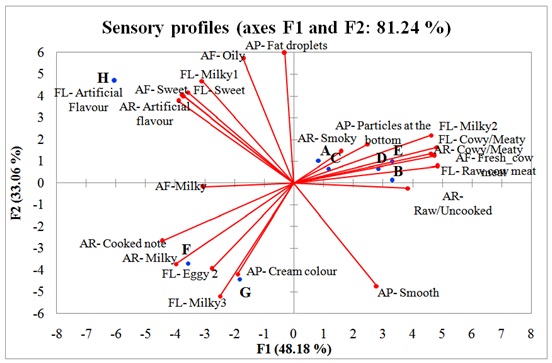 Figure 1: Sensory product map for boiled milk purchased from different processors.
Figure 1: Sensory product map for boiled milk purchased from different processors.The PCA product map shows that 81% of total variance in the data was explained in the first two dimensions as such meaningful interpretations can be made about the product positions in this dimension. Factor 1 (48%) is driven by the cooked aroma in the negative direction and raw/uncooked aroma in the positive direction while Factor 2 (33%) is driven by smooth appearance in the negative direction and particulate in the positive direction. The products were loaded in three distinct areas on the product map with specific attributes characterising each of these areas. Product H was the only product loaded in the space characterised by milky 1 (powdered milk flavour). Other attributes that define this space include sweet taste and after taste, artificial flavour note aroma and flavour, and fat droplets in appearance and oily aftertaste. Products F and G loaded in the product space characterised as milky 3 (full cream milk flavour). In this space, product F was associated more with milky aroma while product G was associated more with the milky 3 flavour (full cream milk). Other attributes characteristic of this space include eggy 2 flavour (raw egg flavour) and cream colour in appearance. The remaining 5 products loaded in the product space characterised by milky 2 (fresh cow milk flavour). Other characteristic attributes of products in this space were raw/uncooked aroma, rawcowy/meat aroma and flavour and fresh cow meat aroma. Smoky aroma is poorly loaded in either dimension 1 or 2 but has a stronger association with dimension 3 which is not shown here. Products A and C were associated more with smoky aroma while products B, D and E were associated more with the raw/uncooked aroma and flavour notes.
Consumer acceptance of boiled milk products
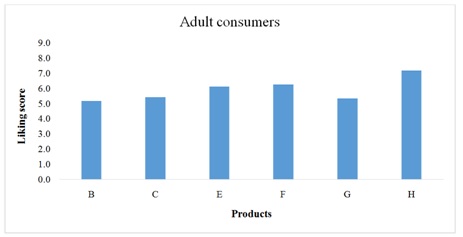
 Figure 2: (A) Mean overall liking pattern of 120 adult consumers for boiled milk samples (1=dislike extremely to 9=like extremely); (B) Mean overall liking pattern of 72 children consumers (1-5 years) for boiled milk samples (1=dislike very much, 2=neither like nor dislike and 3=like very much).
Figure 2: (A) Mean overall liking pattern of 120 adult consumers for boiled milk samples (1=dislike extremely to 9=like extremely); (B) Mean overall liking pattern of 72 children consumers (1-5 years) for boiled milk samples (1=dislike very much, 2=neither like nor dislike and 3=like very much).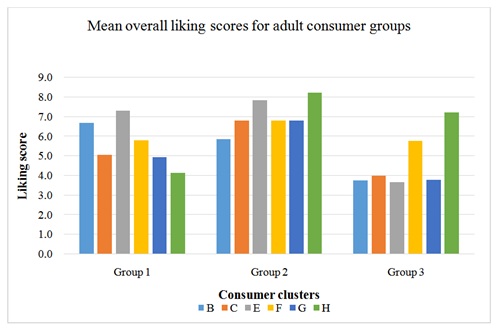 Figure 3: Mean overall liking scores of adult consumer groups after AHC was done (1=dislike extremely to 9=like extremely).
Figure 3: Mean overall liking scores of adult consumer groups after AHC was done (1=dislike extremely to 9=like extremely).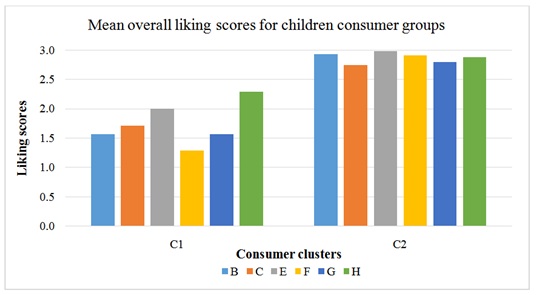
Although the overall liking pattern for adults and children differed, both groups liked product H more than the other products in the set. While the adults generally did not like product B, the children liked this product almost as much as product H. The least preferred products for the children were for products C and G. These products were also not liked much by the adult consumers.
Agglomerative Hierarchical Cluster (AHC) analysis identified three consumer cluster groups for the adult consumers based on their overall liking scores. Group 1 had 16% of consumers, group 2 had 45% of consumers while group 3 had 39% consumers. Groups 2 and 3 consumers both liked product H, however group 3 consumers were generally low product likers while group 2 consumers were high product likers. Group 1 consumers did not like product H overall.
The children consumers were placed into two clusters after AHC. Group 1 (C1) had the largest percentage of consumer, 81% and group 2 (C2) had only 19% of consumers. Similar to the adult consumers, both groups liked product H the most. However, group C2 consumers were non-discriminating in their liking for the products and scored all 6 products highly. The product liking pattern for group C1 consumers was similar to the adult consumers in group 2 who were also the majority of the adult consumers (45%). However, the children liked the products comparatively less than the adults.
Drivers of liking
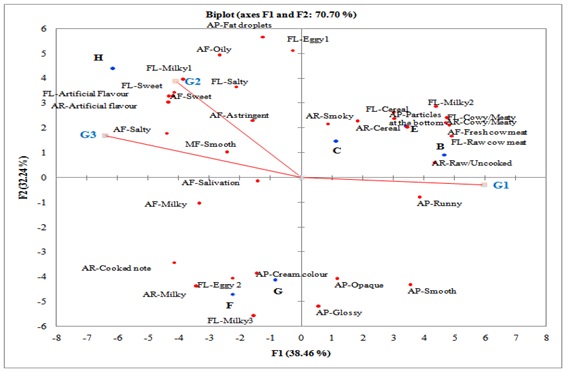
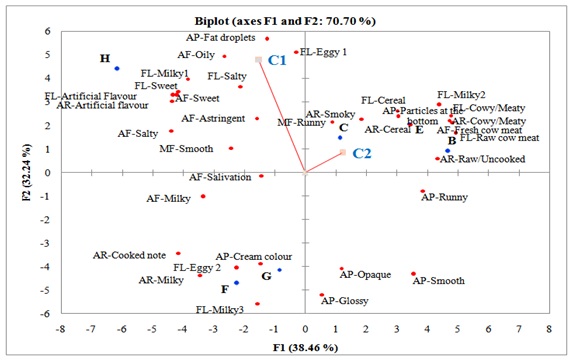 Figure 5: Preference mapping-Principal component biplot showing consumer perception of boiled milk. (A) Overall mean liking scores of the 3 adult consumer clusters. Vectors for the liking scores for the clusters as well as points for the 6 boiled milk samples are shown. G1, G2& G3=adult consumer cluster1, 2 and 3 respectively); (B) Vectors of the overall mean liking scores for the children clusters. C1=cluster1, the largest cluster of the consumer data (81%) and C2=cluster 2 (19%).
Figure 5: Preference mapping-Principal component biplot showing consumer perception of boiled milk. (A) Overall mean liking scores of the 3 adult consumer clusters. Vectors for the liking scores for the clusters as well as points for the 6 boiled milk samples are shown. G1, G2& G3=adult consumer cluster1, 2 and 3 respectively); (B) Vectors of the overall mean liking scores for the children clusters. C1=cluster1, the largest cluster of the consumer data (81%) and C2=cluster 2 (19%).Preference mapping analysis of the children consumer groups showed that the direction of liking for majority of the children group C1, was in the direction of product H. However, the attributes of product H that drive liking for the children was not the same as for the adults. Contrarily in the children, sweet taste and aftertaste were not as strongly associated with their direction of liking as it was with the adults. It is possible that the intensity of sweetness was not high enough for the children’s palate compared with adults. This is not surprising as it was well known in the literature that adults and children have different levels of liking for sweetness intensity [14-16]. For the children in C2, it appears that the oily aftertaste, oil droplets and eggy 1 (boiled egg) flavour of the milk were important attributes that influenced their liking for product H. These attributes together may give a sensation of fullness in the mouth when consumed. The direction of liking for children group C2 was however not well explained in this product map, considering that the liking preference for consumers in this group was not well differentiated by these consumers.
A significant finding was that neither the adult or children consumer groups had the direction of product liking loading towards products F and G. This is interesting as these two products were the ultra-high temperature treated milks that are sold on the market. These milks are perceived to be more safe for consumption, however their sensory attributes did not drive liking amongst either of the consumer groups tested in this study.
CONCLUSION
Fresh milk consumption in Ghana is generally very low and particularly so amongst children and women of reproductive age. This study has provided insight into the sensory drivers that influence consumption of different types of boiled milk products on the local Ghanaian market. Significantly, attributes associated with products that were UHT treated (products F and G) in this study, did not drive liking amongst either consumer groups. Both adult women of reproductive age and children under five years liked the sample H although the attributes that drive liking for the two groups were different. For women of reproductive age, sweet and salty taste, artificial aroma and flavour and smooth mouth feel are important attributes for product liking while for children under five years, oily aftertaste, eggy 1 (boiled egg flavour) and oily droplets in appearance were important attributes that drive liking. For a small majority of adult women of reproductive age however, products that have a raw/uncooked aroma and smooth runny appearance were more desirable. A small majority of children consumers however were non-discriminating between the products and liked all the products about the same. The results of this study show that there is potential to develop the local fresh milk market in the Ghana as they have sensory properties that appeal to the target consumers used in this groups who are also a nutritionally vulnerable group in the population.
ACKNOWLEDGEMENT
The study was funded by the Bill and Melinda Gates Foundation. The funder did not influence in any way, the design of the study, collection, analysis and interpretation of data. The study was also funded with UK aid from the UK government; however, the views expressed do not necessarily reflect the UK government’s official policies.
REFERENCES
- Van de Poel E, Hosseinpoor AR, Jehu-Appiah C, Vega J, Speybroeck N (2007) Malnutrition and the disproportional burden on the poor: The case of Ghana. Int J Equity Health 6: 21.
- Lartey A (2008) Maternal and child nutrition in Sub-Saharan Africa: Challenges and interventions. Proc Nutr Soc 67: 105-108.
- Müller O, Krawinkel M (2005) Malnutrition and health in developing countries. CMAJ 173: 279-286.
- Ampaabeng SK, Tan CM (2013) The long-term cognitive consequences of early childhood malnutrition: The case of famine in Ghana. J Health Econ 32: 1013-1027.
- Koletzko B, Chourdakis M, Grote V, Hellmuth C, Prell C, et al. (2014) Regulation of early human growth: Impact on long-term health. Ann Nutr Metab 65: 101-109.
- Lanigan J, Singhal A (2009) Early nutrition and long-term health: A practical approach: Symposium on ‘Early nutrition and later disease: Current concepts, research and implications’. Proceedings of the Nutrition Society 68: 422-429.
- Claeys WL, Verraes C, Cardoen S, De Block J, Huyghebaert A, et al. (2014) Consumption of raw or heated milk from different species: An evaluation of the nutritional and potential health benefits. Food Control 42: 188-201.
- Cardello AV (1994) Consumer expectations and their role in food acceptance. In: MacFie HJH, Thomson DMH (eds.). Measurement of food preferences. Springer, Boston, USA. Pg no: 253-297.
- Chapman KW, Lawless HT, Boor KJ (2001) Quantitative descriptive analysis and principal component analysis for sensory characterization of ultrapasteurized milk. J Dairy Sci 84: 12-20.
- Oliver SP, Jayarao BM, Almeida RA (2005) Foodborne pathogens in milk and the dairy farm environment: Food safety and public health implications. Foodborne Pathog Dis 2: 115-129.
- van Kleef E, van Trijp HC, Luning P (2006) Internal versus external preference analysis: An exploratory study on end-user evaluation. Quality and Preference 17: 387-399.
- Ares G, Giménez A, Barreiro C, Gámbaro A (2010) Use of an open-ended question to identify drivers of liking of milk desserts. Comparison with preference mapping techniques. Food Quality and Preference 21: 286-294.
- Heyd B, Danzart M (1998) Modelling consumers' preferences of coffees: Evaluation of different methods. LWT-Food Science and Technology 31: 607-611.
- Beauchamp GK, Mennella JA (2009) Early flavor learning and its impact on later feeding behavior. J Pediatr Gastroenterol Nutr 48: 25-30.
- Drewnowski A, Mennella JA, Johnson SL, Bellisle F (2012) Sweetness and food preference. J Nutr 142: 1142-1148.
- Pepino MY, Mennella JA (2005) Factors contributing to individual differences in sucrose preference. Chem Senses 30: 319-320.
Citation: Adjei MYB, Amissah JGN, Parry-Hanson Kunadu A, Acquaah E, Colecraft, E et al (2018) Drivers-of-Liking (DOL) for Boiled Milk among Women of Reproductive Age and Children Aged between One and Five Years in Peri-Urban Communities in Ghana. J Food Sci Nut 4: 034.
Copyright: © 2018 Maame Yaakwaah Blay Adjei, et al. This is an open-access article distributed under the terms of the Creative Commons Attribution License, which permits unrestricted use, distribution, and reproduction in any medium, provided the original author and source are credited.
